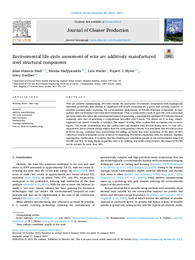Environmental life cycle assessment of wire arc additively manufactured steel structural components

View/
Date
2023ISSN
1879-1786Publisher
ElsevierSource
Journal of Cleaner ProductionVolume
389Pages
136071-Google Scholar check
Keyword(s):
Metadata
Show full item recordAbstract
Wire arc additive manufacturing (WAAM) enables the production of structural components with topologically optimised geometries thus leading to significant self-weight reductions for a given load-carrying capacity. A common question arises regarding the environmental performance of WAAM structural components in comparison with conventional steel structural components. Thus, a comparative cradle-to-gate life cycle assessment has been conducted where the environmental impact of producing a topologically optimised WAAM steel beam is compared with that of producing a conventional hot-rolled steel I-beam. The beams are 2 m long, simply- supported and loaded vertically at midspan. The impact of using either carbon steel or stainless steel is investigated. The results demonstrate that the carbon steel and stainless steel WAAM beams have 7% and 24%, respectively, lower climate change impact than the corresponding I-beams. It is concluded that WAAM can lead to lower CO2-eq. emissions than conventional hot-rolling, provided that mass reductions of the order of 50% (which are readily attainable) can be achieved by employing WAAM in conjunction with, for instance, topology optimisation. Furthermore, it is shown that the shielding gas contributes greatly to the environmental impact of WAAM, and that, by using higher deposition rates or by utilising renewable energy sources, the impact of WAAM can be reduced by more than 30%.
Collections
Cite as
The following license files are associated with this item:

